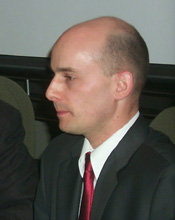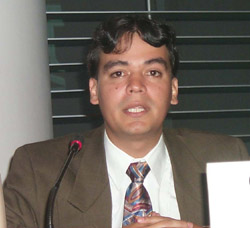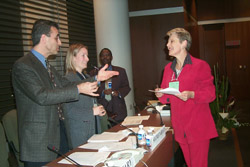 |

Highlights from Wednesday, 21 March 2001
|
 On the third day of the second meeting of the
Experts' Panel on Access and Benefit-Sharing under the
Convention on Biological Diversity (CBD), delegates met in a
morning Plenary session to address complementary options and
elements for guidelines regarding access to genetic resources and
benefit-sharing (ABS). A drafting group then met to develop text
incorporating comments from the morning, which was then reviewed
in an evening Plenary session. On the third day of the second meeting of the
Experts' Panel on Access and Benefit-Sharing under the
Convention on Biological Diversity (CBD), delegates met in a
morning Plenary session to address complementary options and
elements for guidelines regarding access to genetic resources and
benefit-sharing (ABS). A drafting group then met to develop text
incorporating comments from the morning, which was then reviewed
in an evening Plenary session.
Editor's Note: As a matter of policy, the Earth
Negotiations Bulletin does not directly attribute statements in
informal discussions when requested to do so.
Above photo: Members of the drafting group that worked on the elements for
guidelines on ABS.
|
WORKING
GROUP REPORTS:
Co-Chair Martin
Girsbirger (Switzerland) (right) opened the morning Plenary calling for
reports from the Working Group Chairs.
|

The chair of WG-I
reported on the progress made in consideration of examples of user
and provider experience outlined in UNEP/CBD/EP-ABS/2/L.1. He
stressed an overall emphasis on capacity building as the essence
of ABS.
Left photo: Chair L.V. Kalakoutskii (Russian Federation)
.
|

The chair of WG-II introduced the Working Group's report
contained in UNEP/CBD/EP-ABS/2/L.1, highlighting the documents
three sections: identification of stakeholders, examples of
stakeholder involvement and identification of approaches for
stakeholder involvement. She highlighted work on the
identification of specific stakeholders, and WG-II's principle
findings regarding approaches to stakeholder involvement.
Right photo:
Chair Anoja Wickramasinghe (Sri Lanka)
|
COMPLEMENTARY
OPTIONS TO ADDRESS ABS:
|
|

Co-Chair Medaglia (left)
emphasized that
identifying a package of alternative approaches to address
countries' needs is considered to be one of the Panel's main
contributions. He suggested that the morning's discussion focus
on identifying guidelines, while other complementary measures,
such as contractual agreements, capacity creation and information
exchange could be addressed later. He proposed dividing the
discussion on guidelines into comments on characteristics and
elements.
|
CHARACTERISTICS:
|
 Many
experts stressed the need for: flexibility, regarding stakeholders
and use of genetic resources in each case; simplicity;
transparency; and user-friendliness. Many also highlighted the
fact that guidelines should assist countries in developing and
implementing a regulatory regime, keeping a balance between
simplicity and sufficient level of detail. It was noted that a set
of short, voluntary guidelines could be supported by more
elaborated background papers and annexes providing examples of
MTAs and contractual agreements. Many
experts stressed the need for: flexibility, regarding stakeholders
and use of genetic resources in each case; simplicity;
transparency; and user-friendliness. Many also highlighted the
fact that guidelines should assist countries in developing and
implementing a regulatory regime, keeping a balance between
simplicity and sufficient level of detail. It was noted that a set
of short, voluntary guidelines could be supported by more
elaborated background papers and annexes providing examples of
MTAs and contractual agreements.
Right photo: (R-L) Rapporteur,
Maureen Wolfson (South Africa) in consultatio with the
Secretariat's Valerie Normand and Olvier Jalbert
|
ELEMENTS:
 One
expert presented a draft outline for contents and elements of the
guidelines, noting the need for one guideline on sources of
obligation referencing national law. Her elements included: setting
sources and rationale; acquisition of both in situ and ex situ
resources, including key aspects of PIC (role of the national focal
point and national authorities, identification of stakeholders,
processing for seeking consent, distinguishing between processes for
academic and commercial use); basis for use; consistency of terms
for acquisition and supply; annexes containing illustrative
examples; the nature of monetary and non-monetary benefits;
identification of beneficiaries; benefit-sharing for use of
materials acquired prior to the CBD's entry into force; and
management, including tracking, traceability, staff and technology. One
expert presented a draft outline for contents and elements of the
guidelines, noting the need for one guideline on sources of
obligation referencing national law. Her elements included: setting
sources and rationale; acquisition of both in situ and ex situ
resources, including key aspects of PIC (role of the national focal
point and national authorities, identification of stakeholders,
processing for seeking consent, distinguishing between processes for
academic and commercial use); basis for use; consistency of terms
for acquisition and supply; annexes containing illustrative
examples; the nature of monetary and non-monetary benefits;
identification of beneficiaries; benefit-sharing for use of
materials acquired prior to the CBD's entry into force; and
management, including tracking, traceability, staff and technology.
Above photo: Drafting group that produced the text based on comments made
during the Plenary discussion.
|
INDICATIVE
OUTLINE:
 Plenary
reconvened in the evening and experts reacted to the draft
indicative outline of elements for guidelines on ABS. The chair of
the drafting group introduced the guidelines, noting that the
outline provides a broad context, works through scope and principles
in a broadly applicable framework, defines objectives and key
features, and elaborates four elements: steps in the process, roles
and responsibilities of stakeholders, benefit-sharing, and
cross-cutting elements including capacity building and IPRs in ABS. Plenary
reconvened in the evening and experts reacted to the draft
indicative outline of elements for guidelines on ABS. The chair of
the drafting group introduced the guidelines, noting that the
outline provides a broad context, works through scope and principles
in a broadly applicable framework, defines objectives and key
features, and elaborates four elements: steps in the process, roles
and responsibilities of stakeholders, benefit-sharing, and
cross-cutting elements including capacity building and IPRs in ABS.
Right photo: The dias during the evening plenary.
|

 ENB
coverage of ABS-1 ENB
coverage of ABS-1
 ENB
coverage of SBSTTA-6 ENB
coverage of SBSTTA-6
 CBD
Secretariat web site with official
documents and information
for participants CBD
Secretariat web site with official
documents and information
for participants
 ENB's
Introduction to the CBD ENB's
Introduction to the CBD
|